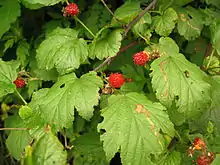Rubus crataegifolius
Rubus crataegifolius, also called Korean raspberry,[1] is a species of raspberry native to East Asia.[2]

Rubus crataegifolius, Aizu area, Fukushima pref., Japan
| Rubus crataegifolius | |
|---|---|
 | |
| May 2009, Japan | |
| Scientific classification | |
| Kingdom: | |
| (unranked): | |
| (unranked): | |
| (unranked): | |
| Order: | |
| Family: | |
| Genus: | |
| Subgenus: | |
| Species: | R. crataegifolius |
| Binomial name | |
| Rubus crataegifolius | |
It is a shrub growing to 1–2 m (rarely 3 m) tall. The leaves are 5–12 cm long and 5–8 cm broad, palmately lobed with three or five lobes, and a serrated margin. The flowers are 1–1.5 cm diameter, with five white petals. The fruit is an aggregate fruit 1 cm diameter, made up of numerous drupelets. The species grows on forest margins and mountain slopes, in areas with moist and well-drained soil.
Its fruit is used for food and is sometimes cultivated; the cultivar 'Jingu Jengal' has been selected for its large fruit.[3] Root extracts have been found to contain substances with anti-inflammatory effects in mice.[4]
Notes
- English Names for Korean Native Plants (PDF). Pocheon: Korea National Arboretum. 2015. p. 612. ISBN 978-89-97450-98-5. Archived from the original (PDF) on 25 May 2017. Retrieved 22 December 2016 – via Korea Forest Service.
- "Rubus crataegifolius Korean raspberry PFAF Plant Database". www.pfaf.org.
- Plants for a Future :Rubus crataegifolius
- Cao Y, Wang Y, Jin H, Wang A, Liu M, Li X (1996). "Anti-inflammatory effects of alcoholic extract of roots of Rubus crataegifolius Bge. (PubMed abstract)". Zhongguo Zhong Yao Za Zhi. 21 (11): 687–8. PMID 9812702.
External links
 Data related to Rubus crataegifolius at Wikispecies
Data related to Rubus crataegifolius at Wikispecies Media related to Rubus crataegifolius at Wikimedia Commons
Media related to Rubus crataegifolius at Wikimedia Commons
This article is issued from Wikipedia. The text is licensed under Creative Commons - Attribution - Sharealike. Additional terms may apply for the media files.